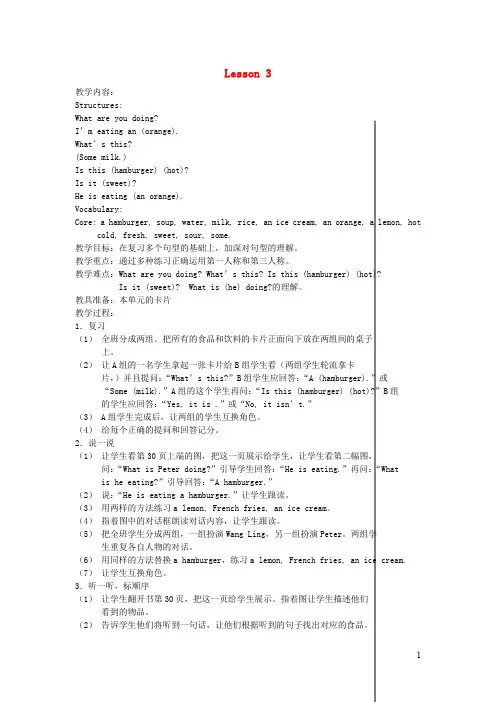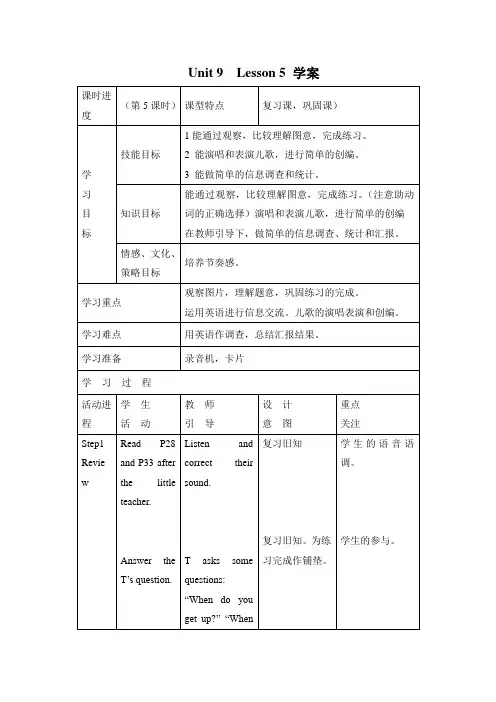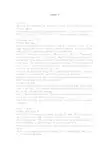北京市21世纪教材第四册教学案例UNITNINEHOTSOUP!
- 格式:doc
- 大小:59.50 KB
- 文档页数:5

Lesson 3教学内容:Structures:What are you doing?I’m eating an (orange).What’s this?(Some milk.)Is this (hamburger) (hot)?Is it (sweet)?He is eating (an orange).Vocabulary:Core: a hamburger, soup, water, milk, rice, an ice cream, an orange, a lemon, hot cold, fresh, sweet, sour, some.教学目标:在复习多个句型的基础上,加深对句型的理解。
教学重点:通过多种练习正确运用第一人称和第三人称。
教学难点:What are you doing? What’s this? Is this (hamburger) (hot)?Is it (sweet)? What is (he) doing?的理解。
教具准备:本单元的卡片教学过程:1.复习(1)全班分成两组。
把所有的食品和饮料的卡片正面向下放在两组间的桌子上。
(2)让A组的一名学生拿起一张卡片给B组学生看(两组学生轮流拿卡片,)并且提问:“What’s this?”B组学生应回答:“A (hamburger).”或“Some (milk).”A组的这个学生再问:“Is this (hamburger) (hot)?”B组的学生应回答:“Yes, it is .”或“No, it isn’t.”(3) A组学生完成后,让两组的学生互换角色。
(4)给每个正确的提问和回答记分。
2.说一说(1)让学生看第30页上端的图,把这一页展示给学生,让学生看第二幅图,问:“What is Peter doing?”引导学生回答:“He is eating.”再问:“Whatis he eating?”引导回答:“A hamburger.”(2)说:“He is eating a hamburger.”让学生跟读。


Unit 9 Hot soup!教案教学目标:知识目标:1. 常用形容词hot, cold, big, small等的用法。
2. 简单描述事物特征的常用句型:The water/ milk is hot/ cold. The jug/ bowl is big/ small.3. 表达饥渴,提出相应建议的句型:I’m hungry/ thirsty. Have some …能力目标:1. 能用英语简单描述食物、餐具的特征。
2. 通过试读、分角色读、齐读、自读等多种方式培养学生的阅读能力。
情感目标:通过谈论食物话题,提醒Mocky小心热汤,为烫着的Mocky提供帮助,培养学生良好的餐饮习惯和关心他人、帮助他人的良好品德。
教学重难点:1. 形容词hungry, thirsty, hot, cold的词意及正确读音。
2. 故事中对话的朗读与理解。
3. 图1对饥渴I’m hungry, I’m thirsty.的表达,及图9对Have some(milk).的表达。
教具准备:图片、牛奶、果汁、热水、冰激凌、录音机、磁带、多媒体课件等。
教学过程:Step 1 热身激趣1. GreetingsT: Hello, boys and girls! How are you? Nice to meet you.Ss: Hello, Mr. Yin. Nice to meet you, too.2. Let’s doT: Let’s do the warming-up exercise.Jump, please.Run, please.Eat a banana, please.Drink, please.Ss: Jump/ run/ eat/ drink(同时做出相应的动作)(设计意图:jump/ run两个动作的使用为呈现情景I’m thirsty.作好准备;eat/ drink 与食物话题紧密相连,通过TPR活动创设英语学习气氛,活跃课堂,拉近师生间距离。

Lesson 51.Review•Hold up the flashcards for this Unit in turn. Elicit from children the correct names.•Pick up one of the food flashcards. Ask the class, “Is this (soup)(hot)?”Elicit, “Yes, It is./No, it isn’t.” Repeat for other flashcards.2.Read and check (??)Student Book page 34•Have the children open their books at page 34. Show your copy of the page. Explain that you will read the sentences together. Tell the children that only one sentence is correct for each picture.•Point to the picture of soup.Say, “What is this?” Elicit, “Some soup.”Point to the vapor. Say, “Is is hot?” Have the children read along with you as they touch each word in their books.•Read the first answer. Have them repeat. Ask the children if the answer is correct. The children should say, “Yes.” Now read the second answer. Again, ask if the sentence is correct. The children should say, “No.”•Now ask the children to check (??) the box beside the correct sentence. •Repeat the procedure for the other pictures and sentences.•Hold up your copy of the page and read the questions and correct answers. Have the children check their own answers.3.A guessing game•Tell the children that we are going to play a guessing game. Have a child come to the front. Tell him/her the phrase a big apple and have the child act it out through body language.•Ask, “What does he/she want?” Have the other children guess the phrase, using the structure He/She wants (a big apple).•Have the child who guessed correctly come to the front and the game continues.4.Let’s chantStudent Book page 35•Have the children open their books at page 35. Draw their attention to the picture. Have them talk about the picture in Chinese.•Tell the children, “We are going to learn a chant about food and drink.”•Read the rhyme to the children, pointing to each word.•Play the tape for the whole rhyme. Have children listen and point to the words.•Play the tape again and have children join in, encouraging them to say or clap with the rhyme.•Have children point to the pictures in their books as they listen to the tape again. They can also add some actions and act the rhyme out.5.Set homeworkStudent Book pages 34 and 35Encourage the children to:•Color the pictures on page 34 in the book.•Say the rhyme to their families.。
北京市21世纪教材第四册教学案例UNIT NINE HOT SOUP!第(2)课时授课日期:2004年6月28 日丰台五小刘艳丽
教学内容:主要结构:Is it..? Yes, it is. No, it isn’t.
主要词汇:sweet, sour, fresh
主要产出语言:I’m hungry./thirsty. Have …. Is it..? Yes, it is. No, it isn’t.
教学目标:1、学生能在体验中学习并能掌握sweet, sour, fresh三个新单词。
2、学生能在活动中运用句子Is it..?及回答进行问答。
3、学生能根据生活实际运用所学句型和词汇。
学习策略:在体验中学习的策略,以及与人合作的精神。
教学重点:1、Words: sweet, sour, fresh 2、Sentences: Is it..? Yes, it is. No, it isn’t.
教学难点:在适当的情境中恰当的运用所学词汇和句型。
学生现状:三年级,已学完课文,以及相关食品饮料的单词。
学生人数:47人
教材分析:共六个单元,本课为本册的第三单元第二课。
教学具:自制课件,教学软件,教学卡片,学生小卡片,头饰,录音机,各种实物。
教学过程:
家庭作业:. 用英语向爸爸妈妈要食品饮料。
板书内容:。